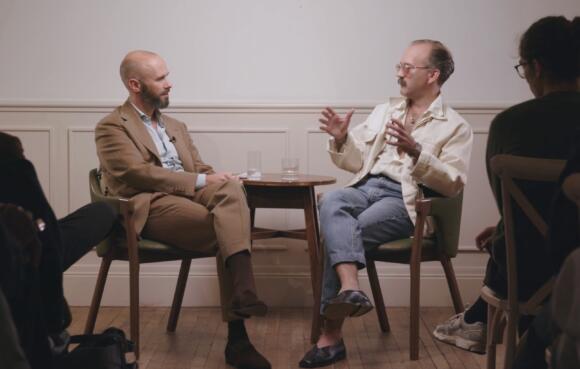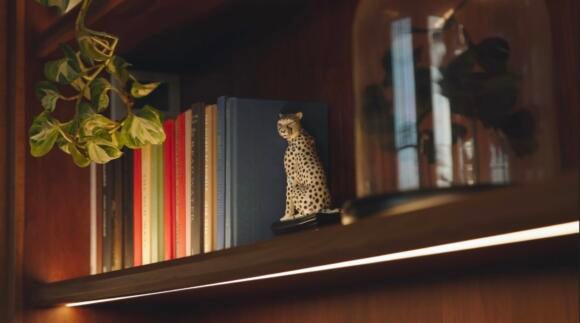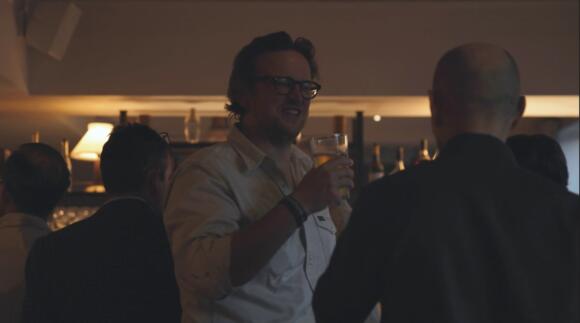The main reason I wanted to bring designer Luke Walker onto our series of talks was his experience working at both fashion brands (Lanvin, McQueen) and classic menswear (Dunhill, Drake’s).
I love what he does at his own brand, LEJ, and we talk about that towards the end. But he has a particular insight into those two types of company, and how the design process works at both, that I've never heard before.
It’s easy for consumers of traditional menswear to be cynical about fashion. It’s all overpriced, for people who want to wear a label, to sell perfume and handbags. Much of that is true, and Luke talks about how that has come to dominate fashion in the years he’s been working.
But there’s also beautiful menswear, that Permanent Style readers might love if they were exposed to it. Fabrics you never see anywhere else; unique colours and yarns; ideas of proportion and design.
Luke talks about an incredible velvet jacket he kept from his years at Lanvin, about the work of Haider Ackermann at Berluti, and about Katharine Hammett cutting up pieces of vintage clothing.
This is a world we never talk about on PS, and it was great to hear about it first hand. Towards the end we come full circle and talk about how design worked on something like the Games Blazer at Drake’s, when Luke was there.
I hope you enjoy it. Apologies for the occasional audio issues, but watch out for the question at the end about chest hair.
The next talk, in mid-November, will be announced soon.
Previous interviews in the series:
- Rubato, on their brand and style
- Tony Sylvester, on style and subcultures
- Ethan Newton, on the evolution of Bryceland’s
- Jamie Ferguson, on his career in photography































A very interesting insight. Whilst LEJ is not for me personally (70s lol) I think the Drakes games blazer is a great piece of design. Whilst the term ‘form and function’ is a bit overused, I think appropriate for this piece. Very useful as a step down from formal tailoring but not as far as a chore coat. I didn’t realise the thinking and design touches that went into it.
What Haider Ackermann did for Berluti was a masterclass in menswear, and I always felt if those collections didn’t sell, no one can make Berluti as a fashion label work, and it has not worked since.
Seems like a thoroughly good chap, having met him in person. However, he manages to take a lot of key menswear staples and put them together in such a way as to look like a 70s pornographer. Maybe that’s the point, I don’t know! Was the golden age for pornography after all.
Hahaha, lol. Great, that was funny. Thanks.
I was thinking Robert Loggia in Scarface…
But seriously, I think your observation regarding the use of menswear staples is interesting. These clothes seem to demonstrate how experimenting with small changes to an outfit can lead to very different results. If he buttoned a few more buttons, moved the shirt collar inside the jacket, and traded the shoes for something in brown suede (probably with socks, but not absolutely necessary), I think this would be a look that many PS readers would wear. Perhaps he is experimenting a bit. Perhaps this is how he always dresses. In either event, it seems more thoughtful (and relatable) than a period outfit.
i think its the moustache, the sunglasses and the open collar.
Didn’t read this before posting my comment. My thought too somewhat. Think it’s the glasses, opened-to the -navel shirt, or the chains ? Can’t say why, but it did remind me of something kinda cool.
Porn on those 8mm home projectors at 13 with other kids from the neighborhood – those were the days!
Quote from Luke towards the end, “we are lazy but very intelligent.” used regarding people not wanting to read but pick up so much from visuals.
A great insight to how human beings interpret scenarios, dress, other people.
So changing the focus slightly from Luke’s meaning when he used it: We are interpreted by intelligent people when they look at us, they make decisions about us without even talking to us.
We are continuously broadcasting ourselves to the world through the way we appear. Even if the intention is to broadcast nothing, that tells the world something about us.
We can not control other people’s perceptions but we can control what we broadcast remembering people are lazy but intelligent.
Luke sounds Australian. Interesting how many big menswear names have come out of there (Ethan, O’Shea, Ronnie Chiu, among others).
Is it intentional that you list Dunhill under both Fashion and Classic Menswear? Seems odd to say he has experience of the two types of companies when you list one company as being both implying they aren’t mutually exclusive anyway and so not really two types.
Nope, that’s a typo, thanks. Should say Lanvin in the first one
Hello Simon.
Cool interview. The inside story’s about fabrics, design and at drakes.. interesting. About the last part, the styling and and how different people make something different with the same clothes… Have you ever helpt people with your one on one sessions with just styling? Sort of creating new outfits without buying something new? I for sure would be interested how somebody else would make outfits together with my already existing clothes.. Cheers
I have, yes Jasper, and good point, that could be nice
Maybe an article showing how two or three people put outfits together from the same pieces of clothing.
Sounds good
I had a look at the websites of two designer brands that were mentioned in the discussion, The Row and Grace Wales Bonner. The Row’s price are ridiculous. £4,480 for the Johnson raincoat and £3,000 for the Harris Harrington, both 85% cotton/ 15% polyamide. The Nantucket Jacket in Nylon (actually 100% polyester ) is £1,810.
Wales Bonner’s DB Andre Jacket, 65% viscose/35% cotton, is £1,470 and made in Italy. I can’t find anything made in Britain on the website. There is nothing which would appeal to PS reader who is interested in classic menswear.
To be frank, these brands’ garments only confirm my perception that fashion designers use hype and exaggeration to justify mediocre quality and extortionate prices.
Gary, as often seems to happen, you’ve missed the point. Why are you talking about whether the clothes are made in Britain? The point is interesting design and fabrication. Even there, I suspect it’s not going to be the kind of design that appeals to you, but don’t assume it won’t appeal to anyone else.
You seem to have missed a key point. At 31.30 Luke says that Grace Wales Bonner does a lot of her tailoring with Anderson & Shephard. That would be a key selling point. but there is no sign of any high quality tailoring on her website. So please tell us what you appeals to you (especially what you buy at full price) on The Row and Wales Bonner’s websites.
I can see how that might be a key selling point for you Gary, but it’s not the point being made generally in the video.
I haven’t bought anything myself at either, but at The Row the pieces I tend to find interesting are the technical garments – ones that are made as sportswear but in more classic shapes.
Maybe next time come along to a talk so you can put questions to the speaker.
Perhaps I can speak to this, as someone who sees the appeal of both styles of dress. I agree with Simon: GWB tailoring at A&S is a selling point to myself, and you, clearly, but it is almost entirely irrelevant for GWB’s marketing. In my experience, people tend to purchase with their senses rather than with their mind. The way something looks, the way it feels, even the way it evokes memories and emotions–these things go to the heart of what makes fashion brands successful.
In my experience, people purchasing expensive clothing want to feel special, whether they project that into the world or keep it as an internal emotion. Fashion brands are exceptionally good at tapping into that ephemeral feeling through unique silhouettes, interesting drapes, fun textures or patterns, or, of course, splashy logos.
The lessons we can take away from this are numerous, especially if, unlike Simon, you have a stronger predilection for more expressive pieces. I do, and at times, I find it difficult to balance quality-price-design. But I don’t see the point in slagging off companies that lean heavily into price+design, because I hope that conversations such as this can help expand the mind of a variety of brands to be more inclusive of variety without necessarily compromising on their core values (which, of course, doesn’t always pan out).
For instance, my favourite brand is Connolly, and something that they’ve done in recent years is post a ‘shared wardrobe’ (unisex designs). This is lovely for someone that might peek into womenswear for inspiration or for individual pieces (such as coats, cardigans, etc), but doesn’t want to mess about with pages of non-applicable items.
All this to say that having these conversations helps both keep the menswear ‘hobby’, which is ultimately what it is, more accessible and understandable, and doesn’t take away from the established member’s enjoyment–and might even help broaden your own perspective.
Cheers, I know I’m cursed with high wordcounts,
Nicolas
No, thanks – that’s one of the most insightful comments I’ve read on this site.
Appreciate the kind words, thanks very.
Just to jump on.
I love how unisex design can introduce a flow and silhouette into men’s wear. We are so fixed on tradition,natura,l materials they bring an inherent stiffness and form..They drape rather than flow.
I think mens” fashion,,with designers using non-traditional fabrics,capture this movement rather better. Now,obviously,there is nothing wrong with our rather narrow sightlines,but,as in art,the fringes influence the centre(eventually) and we should look wider.
As mentioned, outliers equal expense and it’s a difficult balance.
I love movement of rayon and silk shirts,or, the occasional expressive trouser. Grandpa status brings with it a acceptable eccentricity and roving hemlines..
Nicely put Peter, that stirs the imagination
I think these sort of perceptions are not always valid, there are different qualities of everything, even cotton, even polyester.
Quality is always expensive, but expensive is not always quality.
We be our own judge.
Very interesting talk.
The insights of how the haute couture world operates are always very fascinating. Although It does seem that both contemporary menswear and womenswear are so pastiche that it’s really hard to see the value of the design work. They may be able to present vast collections twice a year with this very coherent and organic aesthetic but then the single garments don’t seem to be that original. I mean, Chanel or Dior really changed womenswear with never before seen garments, I can’t picture anything that original in the past 30 years outside of Crocs. It seems that with more fragmented medias and a less elite-driven world it has become harder and harder to make something new stick around. Or maybe clothing are only getting cheaper and cheaper and it’s not really possible to make anything new that’s not extremely simple at the same time.
Great to hear The Row mentioned in the video. I have some knitwear from The Row. You only realise how special the clothes are when you hold them in your hand. If only it weren’t for the prices…
From the pretext of the video conversation, this may be a new kind of experience for the archetypal follower of more traditional-based men’s wear. The other world of clothes – in fashion – is premeditated by the creation process. Starting carte blanche. It will be too expansive to talk about it in a singular comment, but for one example, Joe Casely-Hayford was recently honoured and when he was making menswear and especially suits, with the addition of his son, you can visualise the duality of making contemporary men’s wear and traditional suits. To have a much greater appreciation and understanding of how the traditional craft of making clothes sits within the wider sphere of fashion, it’s important to understand the people who really changed and influenced important periods in fashion. When tailoring traditions have had an evolution from military roots, fashion houses had the liberty to create ideas based on a creative director. It it thanks to English designer Charles Frederick Worth that models were shown on people and the first to sew a visible label within the garment. And references to Lanvin and McQueen – these houses – not brands – cannot be overstated for how much they changed modern fashion. It is thanks for the former’s previous director Alber Elbaz – and the latter’s late designer Lee McQueen for which had its own tailoring department on Savile Row previously led by tailor Ritchie Charlton (of Hayward) – you can see how much fashion and traditional methods of making garments are interlaced. One can inform the other and in the French definition ,,cohabitation” to co-exist.
It’s suffice to say that we want to refer to luxury brands that exist today, its aim is to hire a creative head designer, to produce multiple collections in succession in multiple seasons, have runway shows across different continents, and make company profits by retail markup that can be 4-5x the unit cost. It’s plainly how these companies generate their enormous revenue. Hence why people will come to the fullest realisation that traditional men’s wear and tailoring is more rewarding, more impactful in their lives, and see the real value of making clothes just for them – just as haute couture did for women in many past decades.
Mike, if you really want to understand how haute couture started the “fashion” fashion, look no further than the work of Gabrielle Chanel
Fun and interesting conversation, makes me wonder why music or the punk aesthetic was not mentioned regarding the slimness in tailoring of the “Naughties” – I listened to a lot of post punk but also liked tailoring – The Strokes, Libertines, pick your The Band, etc…” always thought they all looked cool in their slim jeans and jackets. Amazing to think of how much my wardrobe and style has changed, while still has stayed the same in a certain regard. The journey of menswear is very much like the journey of art in the 20th century. I do have to say that I love my games blazers, I have three and they are quite versatile. Thank you Simon and Luke!
Pleasure Pedro, and thanks for the reflections
Being old enough to have been a late 70s punk,it’s often overlooked how close the link was between art(often via suburban art colleges) and many of the original punk bands. In fact,I’d be bold enough to state that was the defining look. Pete Shelley(of Buzzcocks) often took to the stage wearing homemade Mondrian designs ,whilst the European aesthetic of the Bauhaus was copied by all.
Well put, Peter!
Great to see your Solaro in action Simon! Looks ideal for the context of the interview. Still happy with it?
Do you happen to know what Safari jacket Luca was wearing? Loved it’s sort of 70’s “trombeur de femmes” vibe.
It was a cool contrast that worked with you in your Solaro. First few seconds of interview I was kind of focused on how the two looks just worked for me.
Thanks, and yes I am. Still don’t think it’s for a lot of people, as it’s naturally unusual, but I do like it.
I think that’s an LEJ piece, but I don’t know the range well enough to say for sure.
What a breath of fresh air Luke is … so many gems, anecdotes and wisdom (Oh … and a dusting of luxuriant chest hair). Loved it all.